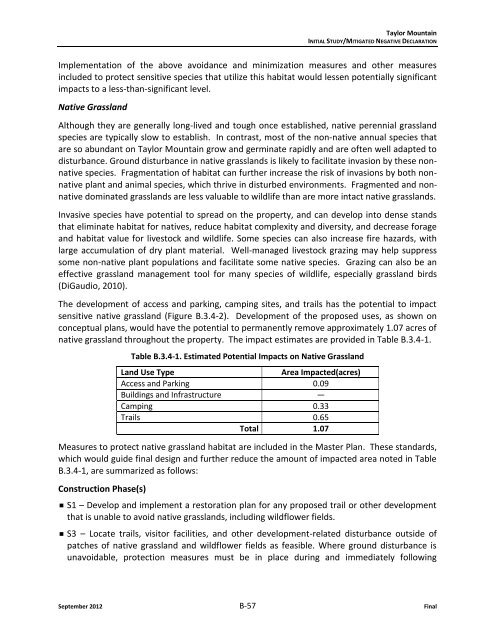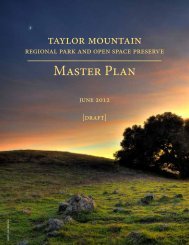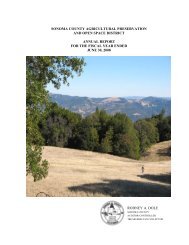Initial Study MND - Sonoma County Agricultural Preservation and ...
Initial Study MND - Sonoma County Agricultural Preservation and ...
Initial Study MND - Sonoma County Agricultural Preservation and ...
Create successful ePaper yourself
Turn your PDF publications into a flip-book with our unique Google optimized e-Paper software.
Taylor MountainINITIAL STUDY/MITIGATED NEGATIVE DECLARATIONImplementation of the above avoidance <strong>and</strong> minimization measures <strong>and</strong> other measuresincluded to protect sensitive species that utilize this habitat would lessen potentially significantimpacts to a less-than-significant level.Native Grassl<strong>and</strong>Although they are generally long-lived <strong>and</strong> tough once established, native perennial grassl<strong>and</strong>species are typically slow to establish. In contrast, most of the non-native annual species thatare so abundant on Taylor Mountain grow <strong>and</strong> germinate rapidly <strong>and</strong> are often well adapted todisturbance. Ground disturbance in native grassl<strong>and</strong>s is likely to facilitate invasion by these nonnativespecies. Fragmentation of habitat can further increase the risk of invasions by both nonnativeplant <strong>and</strong> animal species, which thrive in disturbed environments. Fragmented <strong>and</strong> nonnativedominated grassl<strong>and</strong>s are less valuable to wildlife than are more intact native grassl<strong>and</strong>s.Invasive species have potential to spread on the property, <strong>and</strong> can develop into dense st<strong>and</strong>sthat eliminate habitat for natives, reduce habitat complexity <strong>and</strong> diversity, <strong>and</strong> decrease forage<strong>and</strong> habitat value for livestock <strong>and</strong> wildlife. Some species can also increase fire hazards, withlarge accumulation of dry plant material. Well-managed livestock grazing may help suppresssome non-native plant populations <strong>and</strong> facilitate some native species. Grazing can also be aneffective grassl<strong>and</strong> management tool for many species of wildlife, especially grassl<strong>and</strong> birds(DiGaudio, 2010).The development of access <strong>and</strong> parking, camping sites, <strong>and</strong> trails has the potential to impactsensitive native grassl<strong>and</strong> (Figure B.3.4-2). Development of the proposed uses, as shown onconceptual plans, would have the potential to permanently remove approximately 1.07 acres ofnative grassl<strong>and</strong> throughout the property. The impact estimates are provided in Table B.3.4-1.Table B.3.4-1. Estimated Potential Impacts on Native Grassl<strong>and</strong>L<strong>and</strong> Use TypeArea Impacted(acres)Access <strong>and</strong> Parking 0.09Buildings <strong>and</strong> Infrastructure —Camping 0.33Trails 0.65Total 1.07Measures to protect native grassl<strong>and</strong> habitat are included in the Master Plan. These st<strong>and</strong>ards,which would guide final design <strong>and</strong> further reduce the amount of impacted area noted in TableB.3.4-1, are summarized as follows:Construction Phase(s) S1 – Develop <strong>and</strong> implement a restoration plan for any proposed trail or other developmentthat is unable to avoid native grassl<strong>and</strong>s, including wildflower fields. S3 – Locate trails, visitor facilities, <strong>and</strong> other development-related disturbance outside ofpatches of native grassl<strong>and</strong> <strong>and</strong> wildflower fields as feasible. Where ground disturbance isunavoidable, protection measures must be in place during <strong>and</strong> immediately followingSeptember 2012 B-57 Final







